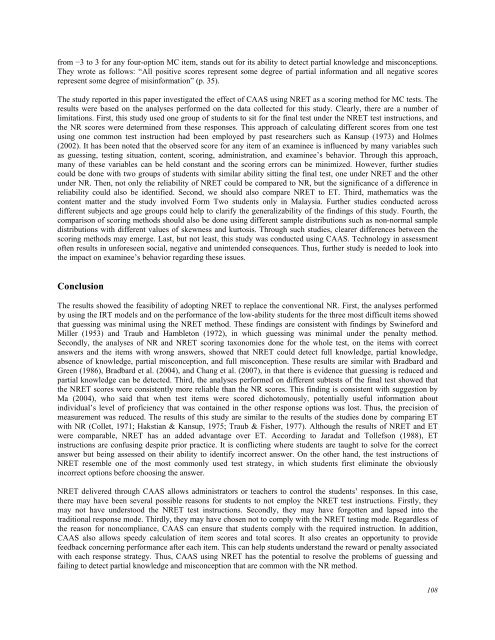October 2011 Volume 14 Number 4 - Educational Technology ...
October 2011 Volume 14 Number 4 - Educational Technology ...
October 2011 Volume 14 Number 4 - Educational Technology ...
Create successful ePaper yourself
Turn your PDF publications into a flip-book with our unique Google optimized e-Paper software.
from −3 to 3 for any four-option MC item, stands out for its ability to detect partial knowledge and misconceptions.<br />
They wrote as follows: “All positive scores represent some degree of partial information and all negative scores<br />
represent some degree of misinformation” (p. 35).<br />
The study reported in this paper investigated the effect of CAAS using NRET as a scoring method for MC tests. The<br />
results were based on the analyses performed on the data collected for this study. Clearly, there are a number of<br />
limitations. First, this study used one group of students to sit for the final test under the NRET test instructions, and<br />
the NR scores were determined from these responses. This approach of calculating different scores from one test<br />
using one common test instruction had been employed by past researchers such as Kansup (1973) and Holmes<br />
(2002). It has been noted that the observed score for any item of an examinee is influenced by many variables such<br />
as guessing, testing situation, content, scoring, administration, and examinee’s behavior. Through this approach,<br />
many of these variables can be held constant and the scoring errors can be minimized. However, further studies<br />
could be done with two groups of students with similar ability sitting the final test, one under NRET and the other<br />
under NR. Then, not only the reliability of NRET could be compared to NR, but the significance of a difference in<br />
reliability could also be identified. Second, we should also compare NRET to ET. Third, mathematics was the<br />
content matter and the study involved Form Two students only in Malaysia. Further studies conducted across<br />
different subjects and age groups could help to clarify the generalizability of the findings of this study. Fourth, the<br />
comparison of scoring methods should also be done using different sample distributions such as non-normal sample<br />
distributions with different values of skewness and kurtosis. Through such studies, clearer differences between the<br />
scoring methods may emerge. Last, but not least, this study was conducted using CAAS. <strong>Technology</strong> in assessment<br />
often results in unforeseen social, negative and unintended consequences. Thus, further study is needed to look into<br />
the impact on examinee’s behavior regarding these issues.<br />
Conclusion<br />
The results showed the feasibility of adopting NRET to replace the conventional NR. First, the analyses performed<br />
by using the IRT models and on the performance of the low-ability students for the three most difficult items showed<br />
that guessing was minimal using the NRET method. These findings are consistent with findings by Swineford and<br />
Miller (1953) and Traub and Hambleton (1972), in which guessing was minimal under the penalty method.<br />
Secondly, the analyses of NR and NRET scoring taxonomies done for the whole test, on the items with correct<br />
answers and the items with wrong answers, showed that NRET could detect full knowledge, partial knowledge,<br />
absence of knowledge, partial misconception, and full misconception. These results are similar with Bradbard and<br />
Green (1986), Bradbard et al. (2004), and Chang et al. (2007), in that there is evidence that guessing is reduced and<br />
partial knowledge can be detected. Third, the analyses performed on different subtests of the final test showed that<br />
the NRET scores were consistently more reliable than the NR scores. This finding is consistent with suggestion by<br />
Ma (2004), who said that when test items were scored dichotomously, potentially useful information about<br />
individual’s level of proficiency that was contained in the other response options was lost. Thus, the precision of<br />
measurement was reduced. The results of this study are similar to the results of the studies done by comparing ET<br />
with NR (Collet, 1971; Hakstian & Kansup, 1975; Traub & Fisher, 1977). Although the results of NRET and ET<br />
were comparable, NRET has an added advantage over ET. According to Jaradat and Tollefson (1988), ET<br />
instructions are confusing despite prior practice. It is conflicting where students are taught to solve for the correct<br />
answer but being assessed on their ability to identify incorrect answer. On the other hand, the test instructions of<br />
NRET resemble one of the most commonly used test strategy, in which students first eliminate the obviously<br />
incorrect options before choosing the answer.<br />
NRET delivered through CAAS allows administrators or teachers to control the students’ responses. In this case,<br />
there may have been several possible reasons for students to not employ the NRET test instructions. Firstly, they<br />
may not have understood the NRET test instructions. Secondly, they may have forgotten and lapsed into the<br />
traditional response mode. Thirdly, they may have chosen not to comply with the NRET testing mode. Regardless of<br />
the reason for noncompliance, CAAS can ensure that students comply with the required instruction. In addition,<br />
CAAS also allows speedy calculation of item scores and total scores. It also creates an opportunity to provide<br />
feedback concerning performance after each item. This can help students understand the reward or penalty associated<br />
with each response strategy. Thus, CAAS using NRET has the potential to resolve the problems of guessing and<br />
failing to detect partial knowledge and misconception that are common with the NR method.<br />
108

















